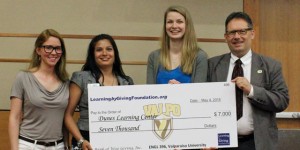Giving It Some Thought
Conversation in Valpo English seminars is often spirited, but students in Prof. Martin Buinicki’s Traditions of Giving and Serving in American Life feel especially invested in class discussions as the semester nears its end. That’s when they turn theory into practice by giving away $10,000.
“It was very challenging,” says Erica Hegarty ’17, an elementary education major who took the course in spring 2015. “I remember leaving that class feeling a little overwhelmed on some days. But there was a lot of benefit in the discussion and deliberation that took place. I learned a lot of practical things, like how to advocate for a cause I support.”
The course, which is required for Valpo’s minor in philanthropic leadership and service, combines a historical survey of American texts related to philanthropy with the class project of distributing $10,000 to local not-for-profit organizations. So far, Valpo students have dispensed a total of $70,000 since Professor Buinicki began teaching the class.
The funds for the course come from the Learning by Giving Foundation, which imposes just a couple of restrictions on its money: each gift the class makes must amount to at least $2,000, and the recipients must be local.
“The organizations have to be local so that the students can make site visits,” explains Professor Buinicki.
In the course syllabus, a schedule of reading, discussing, and formally analyzing texts is interspersed with an equally demanding schedule of activities related to the class project.
After several encounters with texts, the class discusses its giving priorities and discusses a mission statement for its project.
A few meetings later, they settle on a list of potential recipients for the gift, agencies whose work is consonant with the mission. A request for proposals is sent to these agencies.
The students are divided into three committees: one writes the mission statement, one develops the rubric by which grant proposals will be judged, and a third organizes the check-presentation ceremony.
Each student in the class is assigned one agency to research and makes a presentation on that agency to the class. “That, along with the grant proposals, is part of the information available to the class,” Professor Buinicki says.
In the meantime, students continue to drive into the reading list, which includes sermons, essays, speeches, and fiction. It progresses from 17th-century Puritans to philanthropists, social reformers, activists, politicians, and literary figures all the way up to the 21st century.
“It was interesting to see how attitudes toward philanthropy have changed over time,” says Erica. “The literature definitely informed the discussion about the gifts. We had grown together as a class, and the readings certainly came up when we talked about the organizations.”
Local funding organizations recognize the value of this practical experience – so much so that they recruit volunteers from Professor Buinicki’s class.
In spring 2015, Erica and classmate Megan Clarke put their experience to work by helping to review grant proposals for the Center of Workforce Innovations, a local agency that disbursed about $50,000 with Megan and Erica’s help.
“It’s great to see the students think about philanthropy in a very practical way as they are doing the readings,” says Professor Buinicki.
Teaching the class seems to have had an effect on the professor’s own scholarly work, which focuses on 19th-century American literature. His first book, written before he joined the Valpo faculty in 2004, explores debates about copyright law in the early United States and how they influenced perceptions of the author’s profession. A recent publication dealt with Walt Whitman’s Civil war fundraising, and he’s currently at work on a history of representations of philanthropy in American literature.
